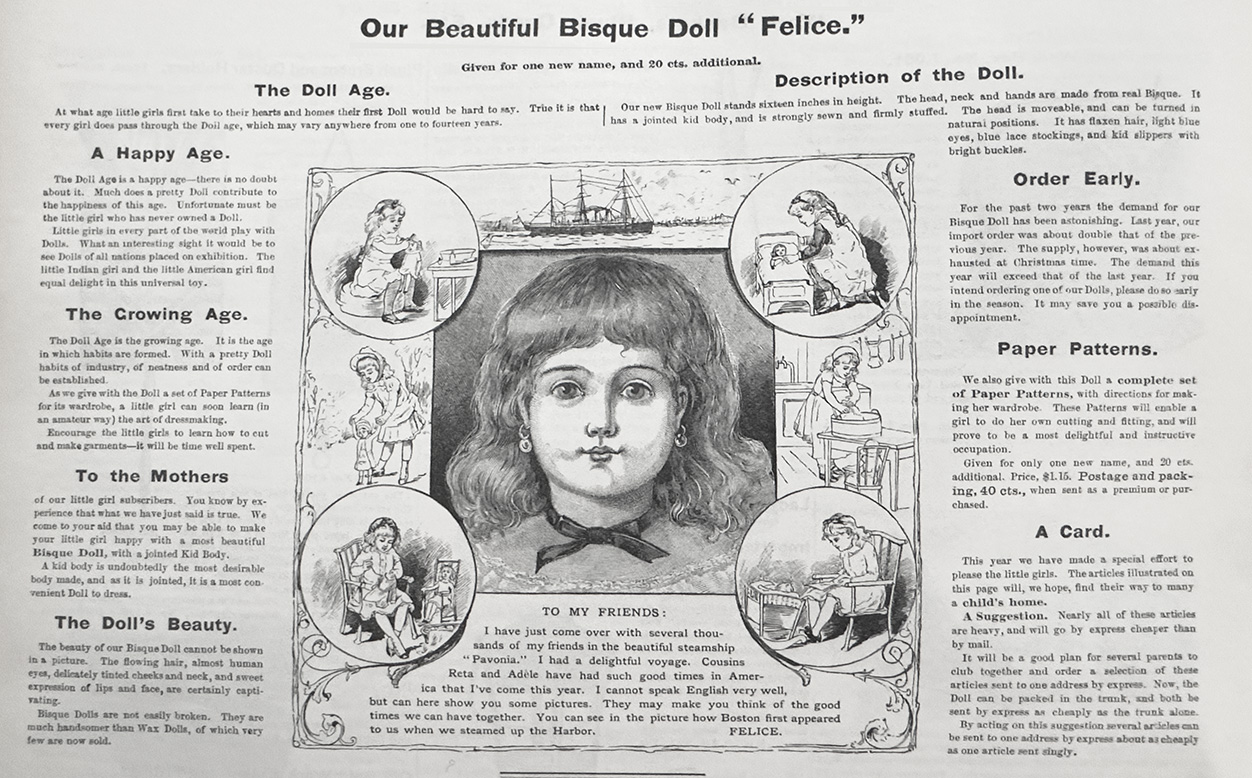Youth’s Companion Magazine Dolls from France
Many Youth’s Companion magazine dolls bore the idea of Paris, France as their origin in the advertisements of the magazine but doll collectors of the 21st century may argue the claim. Many dolls coming out of Europe before the Treaty of Madrid was signed in 1891 did not have marks naming their origin which allowed exporters to possibly hide the German origin in order to sell to those who wanted dolls from the French market.
One often finds dolls on eBay or Rubylane for sell that have titles such as “Antique German Doll French market.” Some of the Youth’s Companion dolls may have been such as these. For the sake of the post, all the dolls claimed by the magazine as French are here categorized as “French.” One will notice that as the years pass 1891 the words France disappear from the advertisement claims.
Dolls of 1880 and 1881
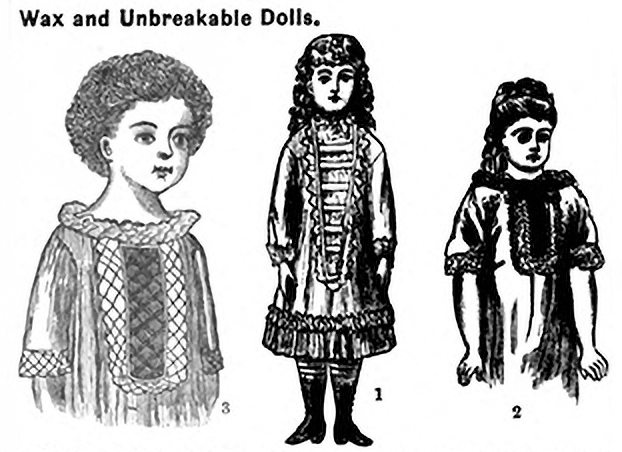
In 1880 the dolls of Youth’s Companion magazine consisted of a wax doll and unbreakable dolls. The magazine claimed they dolls came from Paris.
Doll #1
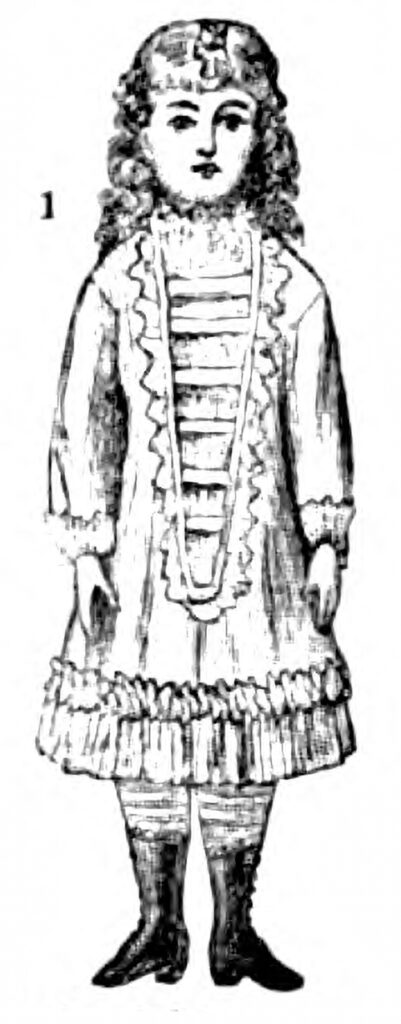
The wax doll, labeled Doll #1, had golden hair, black eyes, and “nicely” dressed. Today you might describe her as a “fully dressed” doll. She wore stockings and boots and stood 14 inches tall with “eardrops” in her ears.
They offered her for one new name to the magazine and with postage and packing at 24 ₵. One could buy her for $1 with postage included.
Doll #2 & #3
The magazine calls dolls #2 & #3 brother and sister who came to America from Paris to live with their cousins. Doll #3, the girl, was 14 inches high. Doll #2, the boy, stood 19 inches high. One could buy either for $1.20 postage included or for 24 ₵ postage only for one new name subscription to the magazine
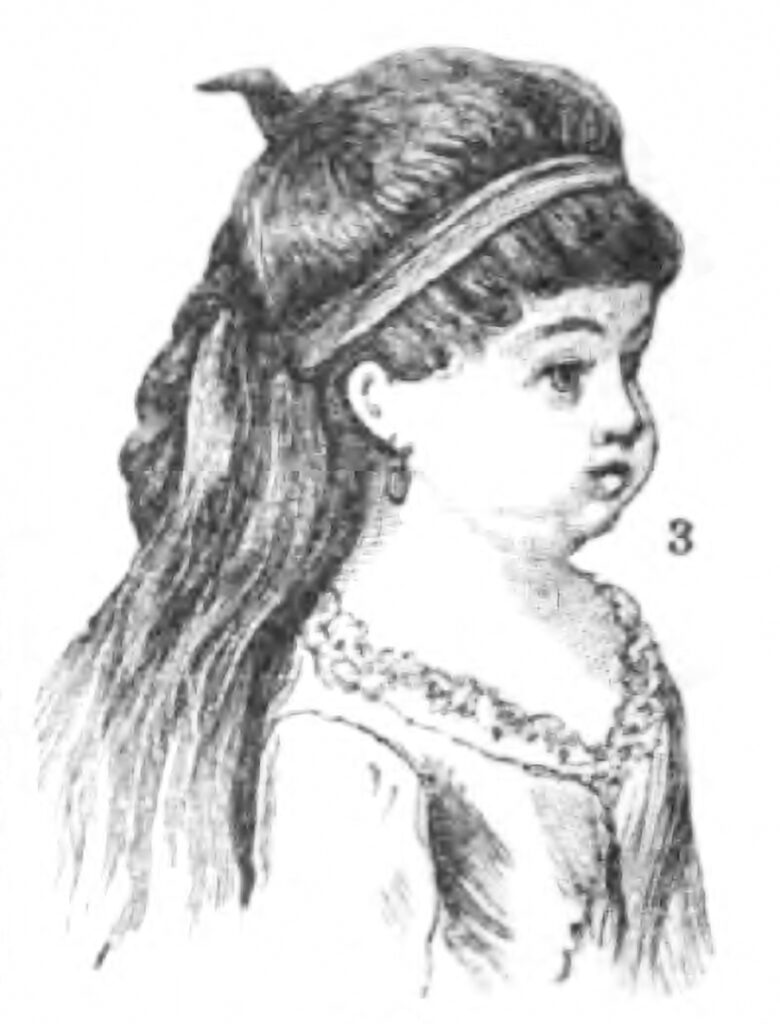
From the image shown in 1880 one might believe doll #3 was a type of French fashion doll. But in 1881 they present a better illustration of doll #3 turning her for a partly side profile that reveals she is more of a dolly type and a better view of her wig and hair style. Nothing more is said regarding these about what they are made of or how they were dressed.
Youth’s Companion Magazine Dolls of 1882-1884
The Youth’s Companion magazine offered five dolls in 1882 that appeared over the next three years dependent on stock. The last edition from October 1882 features all five. They did not have name but had numbers instead: No. 114-2, No. 276-0, No. 2055-46, No. 150-5, and No. 2375-5.

| Doll Number | Year Offered | Dress | Height | Make |
| 114-2 | 1882 sold out | partly dressed with hat, ear drops, necklace, and shoes | 15 in with shoes | not mentioned |
| 276-0 | 1882, 1883 sold out | fully dressed | 15 in | WAX face, neck and shoulders |
| 2055-46 | 1882, 1883, 1884 | undressed with chemise only | 18 in | WAX face and neck |
| 150-5 | 1882, 1883, 1884 | undressed with dark morocco high laced boots and blue lace stockings | 16 in with shoes | kid body unbreakable head (make unknown) |
| 2375-5 | 1882, 1883, 1884 | blue eyes, red shoes, rings in her ears, | 10 in | rubber doll, whistles if pressed |
The 1884 Youth’s Companion offered three dolls they labeled by numbers. The same dolls appeared in 1883 except for doll no. 276-0 and except for doll No. 114-2 that appeared in 1882. Dolls 276 and 114 were both fully dressed so we might assume the magazine sold out of these dolls and were still selling stock leftovers in 1884. The magazine claimed they all came from Paris. Today collectors may conclude from the illustrations that the dolls were German made (French imitations).
Doll 114-2
Doll, No. 114-2 (2nd from left in image above) wore a necklace and earrings or “ear-drops” and a hat upon her head. She stood 15 inches tall in her shoes. No details describe whether she was made of bisque, wax or papier mache. She was only offered in 1882 and evidently sold out possibly due to her being fully dressed with accessories!
Doll 276-0
Doll, No. 276-0 (on right in image above) in the 1883 volume came fully dressed in typical 1880s styled dress. Her face, neck and shoulders were made of wax and she stood 15 inches tall. She was not offered in 1884.
Doll 2055-46
Doll, No. 2055-46 (in center in image above) at 15 inches had a face and neck or shoulderplate of flesh colored wax and long hair wearing a simple chemise but advertised as undressed. She sold for 75 cents. This doll appeared each year from 1882 to 1884.
Doll 150-5
Doll, No. 150-5 (2nd doll from the right in image above) with a kid leather body, dark morocco high laced boots, and blue stockings stood at 16 inches. The magazine describes her head as unbreakable with no other details. From the illustration one might assume her head was made of a type of papier mache. She sold for 70 cents. This doll appeared each year from 1882 to 1884
Doll 2375-5
Doll, No. 2375-5 (on left in image above) was a rubber dolls that stood a petite 10 inches with blue eyes, earrings, and red shoes. They claimed she was unbreakable and sold her for 75 cents. The magazine doesn’t describe her make. This doll appeared each year from 1882 to 1884
Youth’s Companion Magazine Dolls 1885-1888
Reta 1885
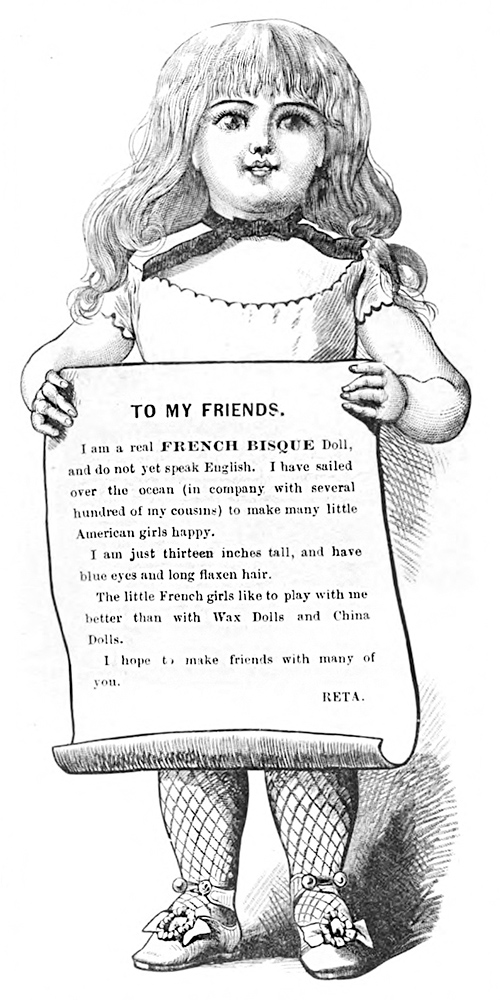
Introduced in 1885, the magazine claimed Reta was the most beautiful and most substantial doll they had ever offered up to that time. They claimed she stood only 13 inches tall with head, neck and hands made from French bisque on a kid leather jointed body. One may understand that “neck” stood for shoulder plate because they claimed her head could turn in natural positions making it a swivel neck. She appears to have a closed mouth and it is not possible to see if she had pierced ears or not from the illustration.
They described her hair as long and flaxen with “human” like eyes. She wore lace stockings and velveteen slippers. In the ad the illustrated doll has no costume except for a ribbon around her neck, the lace stockings, and the velveteen slippers with the bow & buckle. The shoes appear to be white. One can also see that the bisque arms begin above the elbows and see the scalloped edges of the typical kid leather body.
Reta’s Message
In the ad Reta holds a large sheet of paper with a message:
TO MY FRIENDS: I am a real FRENCH BISQUE Doll, and do not yet speak English. I have sailed over the ocean (in company with several hundred of my cousins) to make many little American girls happy. I am just thirteen inches tall, and have blue eyes, and long flaxen hair. The little French girls like to play with me better than with Wax dolls and China dolls. I hope to make friends with many of you. – Reta
French Bisque Doll. (1885, October 29). In Youth’s Companion, Volume 58. No. 44. p.448.
Adèle 1886
Youth’s Companion magazine introduced Adèle in the October 28 issue of 1886 on page 416. The magazine promises a beautiful bisque doll and paper patterns for her wardrobe for one new name plus an additional 15¢ for subscribing to the magazine.
One could also buy her for $1.15 with 35¢ towards postage and packing.
Adèle’s Description
The advertisement claims her head, neck (shoulderplate), and hands were all made from real French bisque; and she had a jointed well stuffed kid leather body. The also claim she had a movable head that could turn in natural position. They also describe her eyes as “human” referring to their shape and the cut of the glass. The ad states she was 15 ½ inches tall with lace stockings and bright buckles on her shoes.
Must of the description can be seen in her illustration. Her illustrated portrait allows shows a doll with long flowing hair, a closed mouth, and pierced ears. She wears a tied ribbon around her neck to cover the joint for her movable swivel neck on a bisque shoulder plate with a square neck covering of either a chemise or the leather itself. One can also see her knitted lace socks and shoes with buckles.
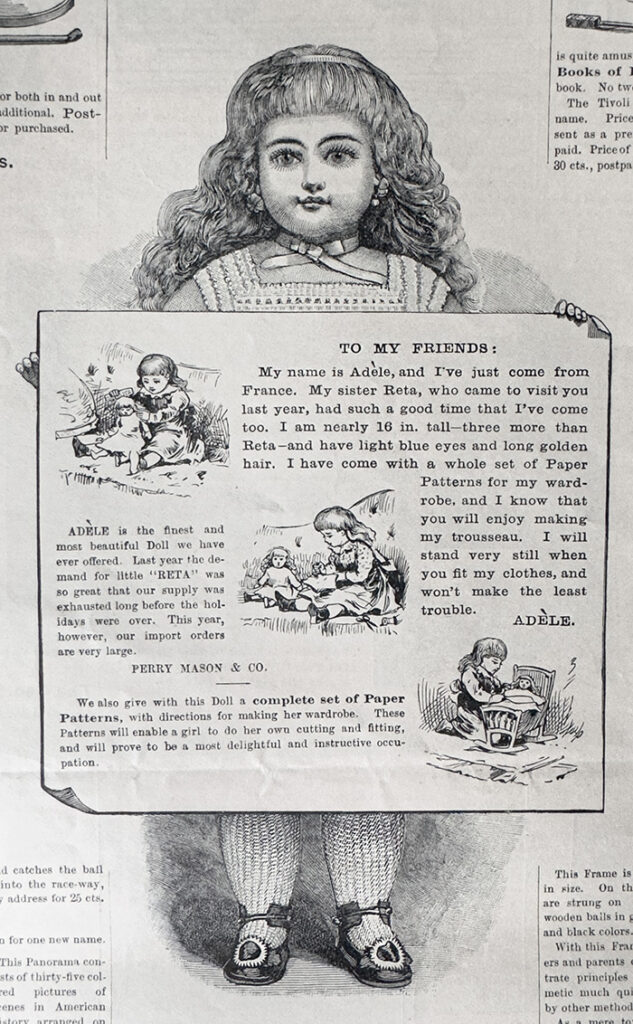
Adèle’s Message
Adèle holds a large square banner in her hands with three illustrations of a child playing with a doll. On the banner is a message from her to the children in America:
“TO MY FRIENDS: My name is Adèle, and I have just come from France. My sister Reta, who came to visit you last year, had such a good time that I’ve come too. I am nearly 16 in. tall – three more than Reta – and have light blue eyes and long golden hair. I have come with a whole set of Paper Patterns for my wardrobe, and I know that you will enjoy making my trousseau. I will stand very still when you fit my clothes, and won’t make the least trouble. – Adèle.
Beautiful Bisque Doll. (1886, October 28). In Youth’s Companion. p.416
Adèle’s Folding Chair

The magazine offers a small folding chair made of birch for Adèle as well as the Reta doll from 1885. The 11 inch chair with its cloth seat and a fancy carved back cost 25¢ with an additional 15¢ for postage and packing.
Felice 1887

Introduced to readers on page 476 of the 1887 volume, Youth’s Companion described Felice as a 16 inch doll, the largest doll they had ever offered up to that time. The illustration mirrored the Adele image in 1886 in most ways with the exact same details. One would have to have both Adele and Felice original dolls with their paper work to be able to identify today how they might have truly differed.
Coleman’s Clue
Coleman’s Encyclopedia of Dolls includes a photo of a doll she claims is Felice. Coleman explained the doll in the photo is marked 154 or 164 on the back of the head. The bisque hands are very short and curled. The mold numbers of Adele and Felice might have differed, if Adele had a mold number.
Right is a very small doll head with the 154 mold number. She is too small to be Felice, but the doll head may be by the same manufacturer as Felice due to Coleman’s image reference. (It should not be confused with the Kestner 154 which was registered later in the 20th century.)

Felice’s Description
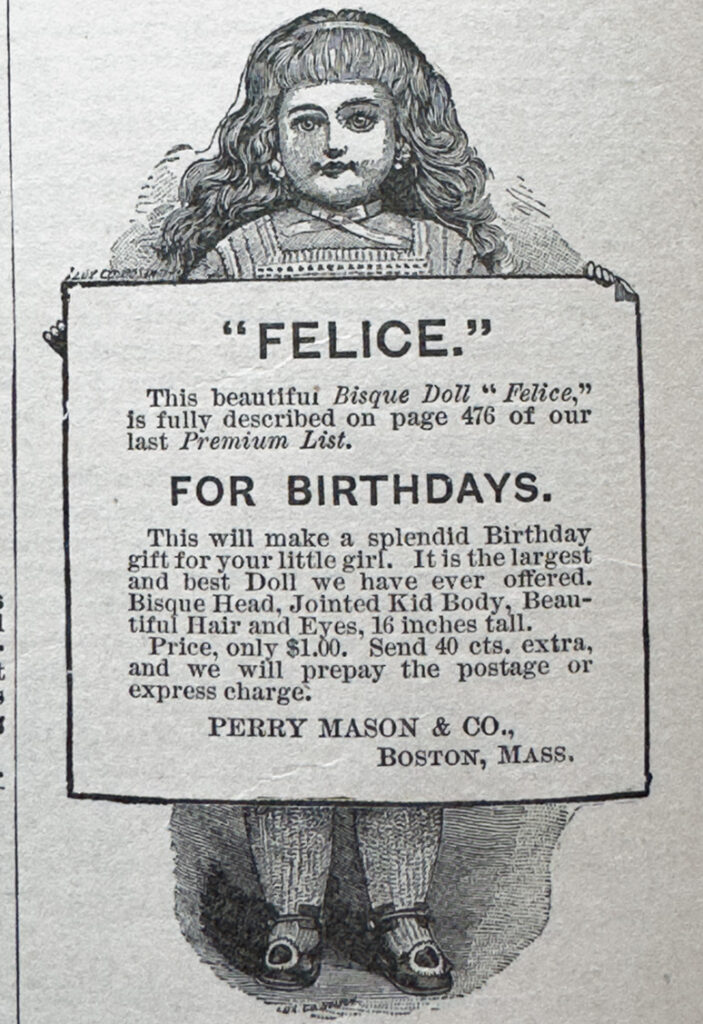
The head, neck (shoulder plate), and hands were made from real bisque. She had a jointed kid leather body strongly sewn and firmly stuffed. The ad claims the head was movable so we can identify Felice today as a “swivel neck.” Furthermore she had what they called “flaxen” hair, light blue eyes, blue lace stockings, and kid (leather) slippers with bright buckles (showing an upgrade in the shoe from the doll Reta that came in 1885). Also important to notice, the Felice doll had a closed mouth and wore earrings in the illustration showing she had pierced ears.
Smaller ads that followed in editions that came after her introduction show a full Felice doll holding her sign giving readers a view of her lace socks and buckled slippers. In the ad one can see the shoes are dark, unlike the white or lighter shoes of Reta in 1885.
The magazine claimed Felice was from France, but she may have been a German manufactured doll made to mimic the French market. Germany was not yet required to mark the bisque with its place or origins so “Germany” or “DEP” was not yet appearing on doll heads. This fact allowed sellers to claim their dolls were French without buyers knowing the truth of the origins.
Felice’s Message
In the introductory advertisement, the magazine includes a message from Felice to the readers.
Our Beautiful Doll Felice. (1887, October 27). In Youth’s Companion. p.476TO MY FRIENDS
I have just come over with several thousands of my friends in the beautiful steamship “Pavonia.” I had a delightful voyage. Cousins Reta and Adele. have had such good times in America that I’ve come this year. I cannot speak English very well, but can here show you some pictures. They may make you think of the good times we can have together. You can see in the pictures how Boston first appeared to su when we steamed up the Harbor. Felice.
Glasgow by J. & G. Thomson & Co. built the Pavonia steamship in 1882 for the Cunard Line for service between Liverpool and Boston. It’s service ended in 1900. (One might be able to use passenger lists of the Pavonia from 1886 or 1887 to narrow down the possibilities of tradesmen bringing the Felice dolls to Boston. This could help lead the way to discovering her original manufacturer.)
Felice’s Saratoga Trunk
The magazine encouraged parents to buy Felice’s saratoga trunk and have the doll sent in her trunk to save on space and cost of shipment. Her trunk bore a label on one side that read “F.A.P. PARIS, FRANCE.” The trunk measured 16 inches long, 10 inches wide and 12 inches high and came with a lock and key. The trunk had leather straps and handles along with metal sheath and guards. It sold for $1.25 or only 25 cents for a new subscriber.
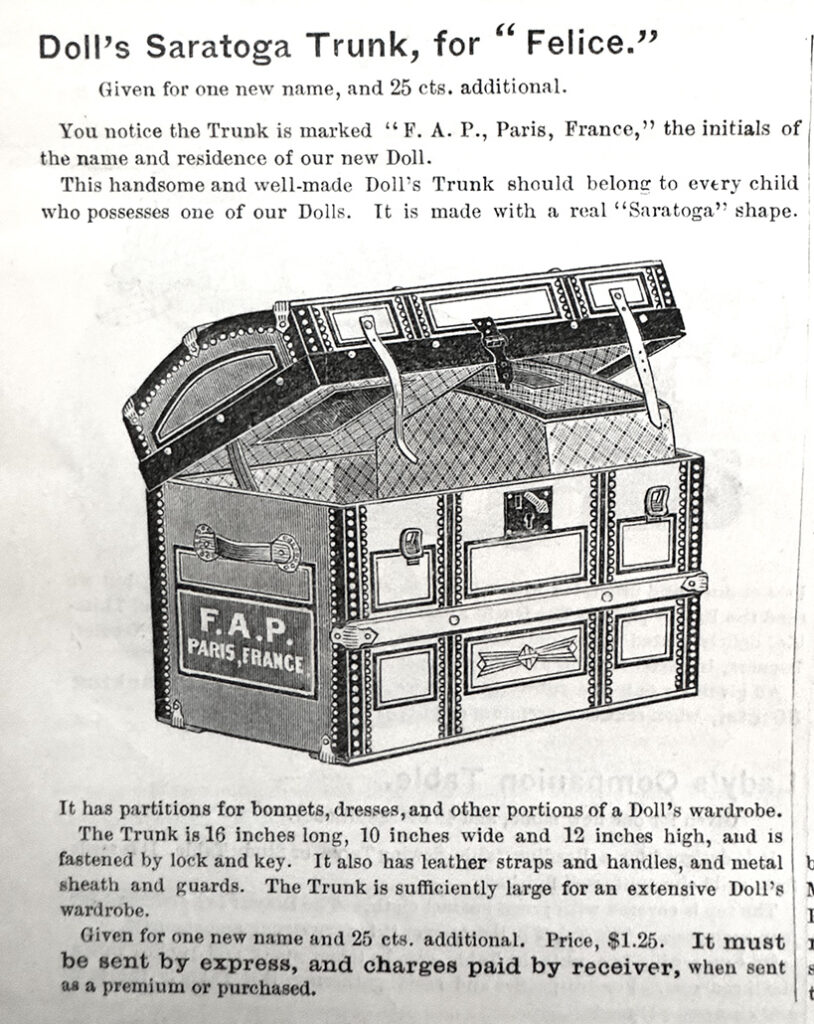
Felice’s Paper Patterns
The magazine offered a complete set of paper patterns for the Felice doll with directions for making her wardrobe. They claimed the patterns enabled a girl to do her own cutting and fitting, and would “prove to be a most delightful and instructive occupation.” They sold the patterns for $1.25 but sent the patterns to a new subscriber for 20 cents. Postage and packing cost an additional 40 cents.
Elena 1888

In 1888, Youth’s Companion magazine introduced “Our New Jumeau Pattern Doll, Elena.” With ball and socket joints at the shoulders, elbows, knees, and hips, she differed from all dolls that came before her. Elena stood 16 inches tall just like Felice did before her, but Elena they claimed was larger and heavier than their previous dolls. Felice with the leather stuffed body would have been lighter than the composition jointed bodies modeled after Jumeau.
Her head jointed at the neck could move and turn freely. The magazine claimed she had beautiful bisque, natural eyes, and flowing Hair of the most luxuriant growth. Also unlike Felice, Elena had slightly parted lips revealing “pearly porcelain teeth.” (It is unknown if the hair was real hair or mohair).
The magazine carefully words the statement that Elena was “made after the celebrated Jumeau.” This indicates that she was not a Jumeau doll, but one made to resemble the doll. This brings in the possibility of the German dolls manufactured to mimic the French market. In 1888 German manufactured dolls could pass as the coveted French dolls without buyers knowing their true origins because the Treaty of Madrid was not in place until 1891.
Elena’s Paper patterns
She came with paper patterns for her trousseau just like the Felice doll before her.
Elena’s Saratoga Trunk
Youth’s Companion magazine also offered a saratoga trunk for Elena just like Felice’s trunk. The only difference was in the label. The label on the side read “E. A. P. Paris France” just as Felice’s trunk read “F. A. P.” Elena’s trunk sold for $1.25. A new subscriber received the trunk for the low price of 25 cents.

Youth’s Companion Magazine Dolls of the 1890s
During the 1890s the magazine stops advertising dolls from France, but instead calls the dolls European or imported.
Marguerite 1891
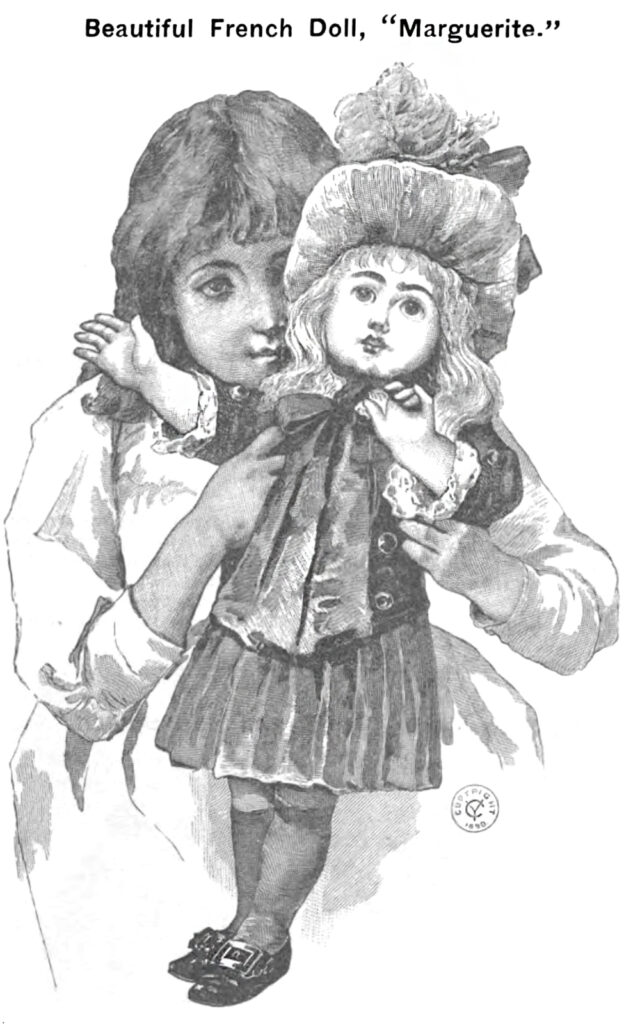
Marguerite receives her introduction in October of 1891 on page 42 of volume 64. The short ad does not provide a height but shows a young girl holding her large doll up for viewers. If proportions are correct in the illustrations one might assume the doll stood more than the usual 16 inches of Elena and Felice. The advertisement claimed that the doll was very much like Elena, “a European doll after the celebrated Jumeau model, having the ball and socket joints at the elbows, shoulders, kneeds and hips,” and jointed at the neck. One can see from the illustration that her wrists are fixed and her lips slightly parted.
Marguerite did not come with paper patterns nor a trunk, but the magazine did offer a different doll with a trunk. Her name was Dolly Dimple.
Dolly Dimple 1891-1893

Dolly Dimple was an all bisque doll that stood only six inches tall. Her illustration show a chubby faced mignonette doll with curly wig and strapped boots. An all bisque doll collector might even be able to decipher the manufacturer just by looking at her boots!
She had a movable swivel socket head with jointed movable arms and legs. The illustration shows she was not jointed at the elbows.
Dolly Dimple’s Trunk of Treasures
This first Dolly Dimple came with an extra dress, a set of underwear, 1 mirror, 1 brush, 1 comb, 1 necklace, 1 fan and one watch and chain all inside her saratoga doll trunk. In February 1892 the Dolly Dimple ad gives the measurements of the trunk as 6½X4 inches. By the illustration one can tell it differs from the trunk provided for Felice and Elena.
Dolly Dimple in October 1892 changes her costume and faces more toward the reader revealing those strapped boots.

Vera 1892
Brown-eyed Vera and a Fringed Valance Hammock come to readers in 1892. The doll without the hammock was offered to new subscribers. The imported doll does not receive the boast of being French this year. The magazine described her having pretty brown eyes and heavy blonde hair with natural teeth. Her half kid body stood 14 inches tall with a swivel bisque head, bisque hands, and movable arms and legs. She came to children simply dressed in a garment trimmed with lace edging, black stockings and black opera slippers.
Vera’s Paper Patterns
Once again the magazine offered paper patterns for making dresses for Vera. The set included patterns for dress, a Mother Hubbard Wrapper, Sacque and Underclothes.
Vera’s Hammock
The 42 inch hammock was woven in colors with a fringe and spread to 14 inches wide and came free with each doll whether ordered as a premium or on sale. New subscribers did not receive the hammock, only the doll.
Little Daisy Bright Eyes 1893-1894
Little Ringlet was her nickname at 14 inches tall. In her message to readers, the dolls let’s everyone know that her real name was Little Daisy Bright Eyes. Daisy Bright Eyes had a kid leather body filled with cork and a head of bisque with long hair in curly ringlets. Her eyes would close to sleep, the first doll the magazine offered with movable eyes.
She sold for $1 with 40 cents extra for postage. This doll claimed to have traveled to the world fair which would have been the World Fair where she got the style for her hat. That year the world fair was held in Chicago, the World’s Columbian Exposition.
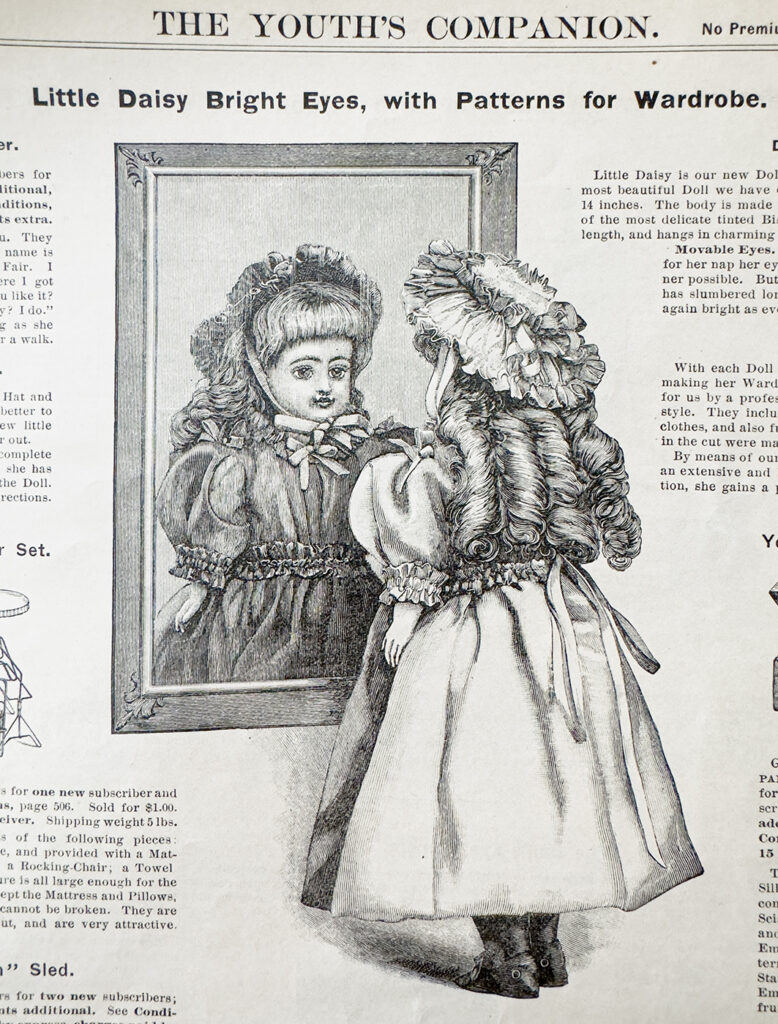
The hat and dress did not come with the doll, instead the buyer received paper patterns with directions for making them.
Daisy Bright Eyes’ Hammock
Daisy Bright Eyes came with a 42 inch long hammock at 14 inches wide of woven colors with a fringe.
Daisy Bright Eyes’ Saratoga Trunk
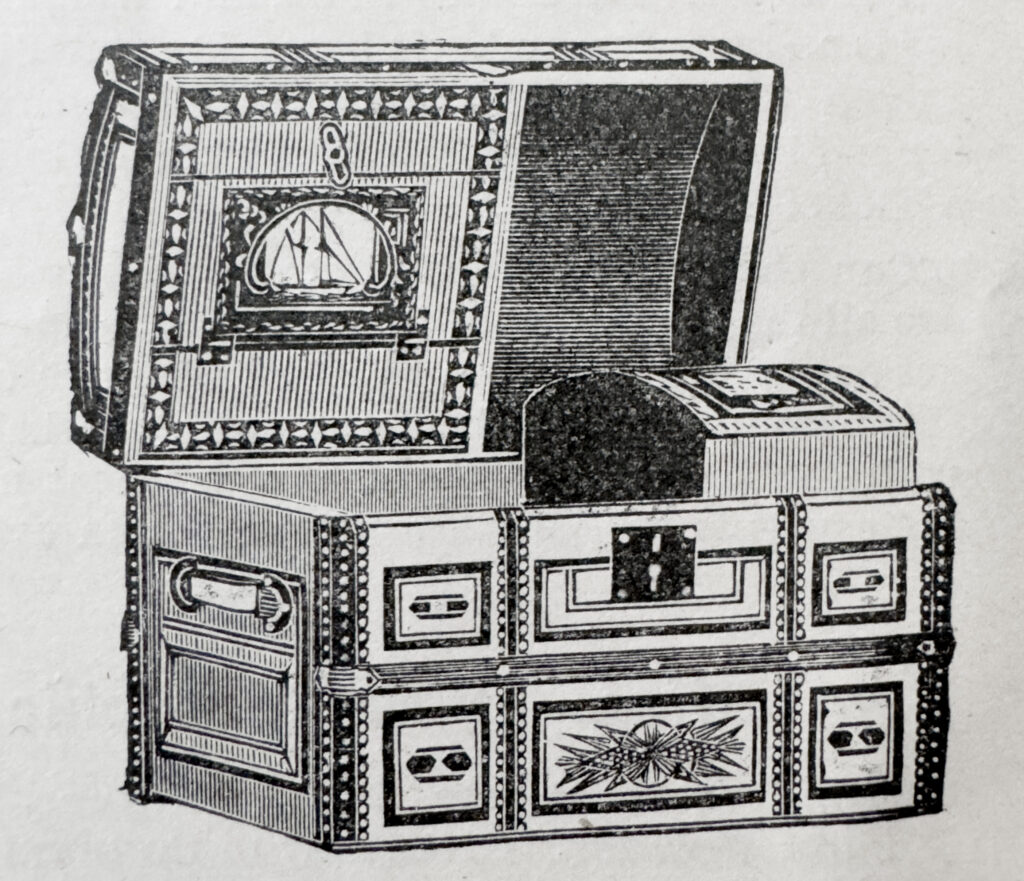
The magazine offered a Saratoga trunk for Little Daisy Bright Eyes just as they did for other dolls in the past. The magazine did not advertise the trunk with initials like those for Felice and Elena.
The trunk measured 16 inches long and had a lock and key, metal snap fasteners, guards, and inside partitions.
Little Bright Eyes 1896
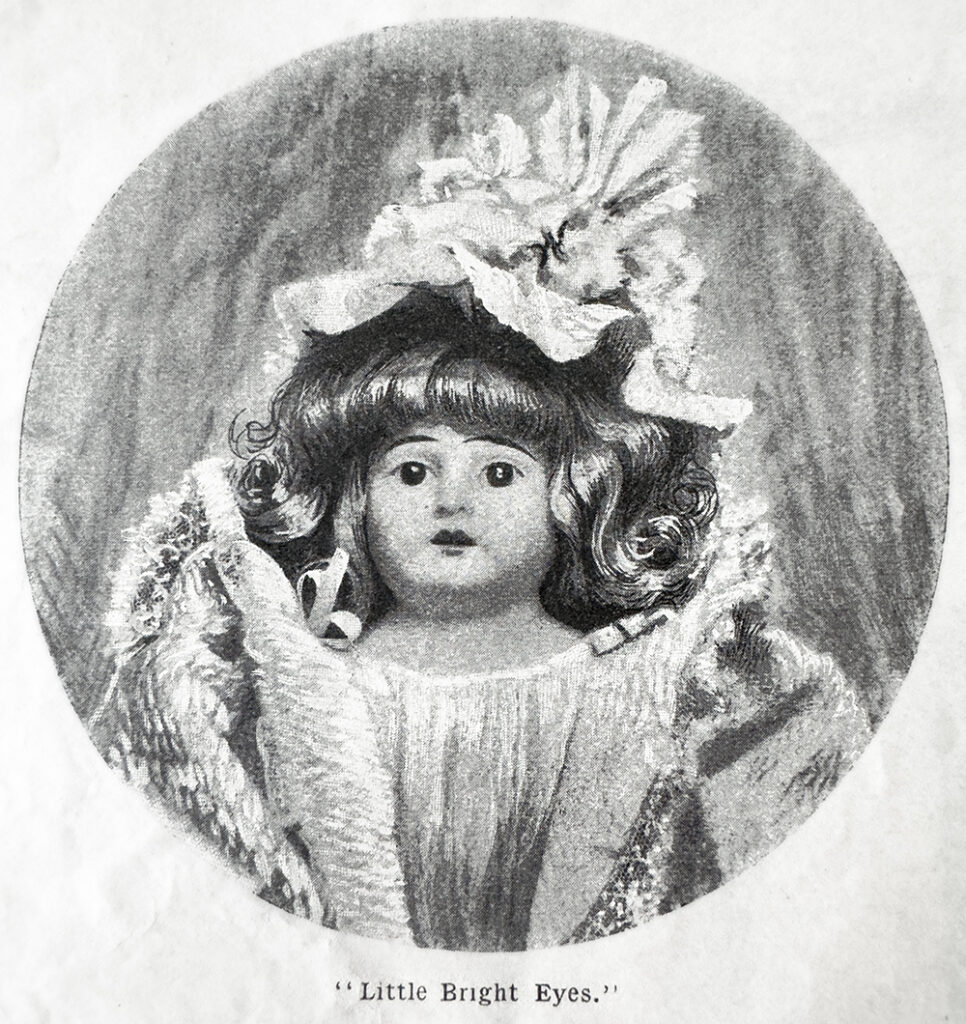
This illustration appeared in the 1896 October issue advertising Little Bright Eyes. She bore the same description as Little Daisy Bright Eyes from 1893. This doll does not appear to have the long ringlet curls as Daisy.
Standing 15 inches high with long curly hair in a kid leather body. They explained that she had movable joints at the knee, hip, elbow, and shoulders.
She too came with the same paper patterns as described in 1893. The price remained the same at selling for 90 cents with 25 cents for postage.
Little Bright Eyes’ Saratoga Trunk
Just like the dolls from the 1880s, Little Bright Eyes of 1896 also had a Saratoga Trunk. Only she did not have a label on the side with her initials like Felice and Elena did. The trunk was covered with galvanized iron at 10½ inches long with a lock and key. It had metal snap fasteners and an inside tray. It sold for 90 cents and weighed 3 lbs for shipping.
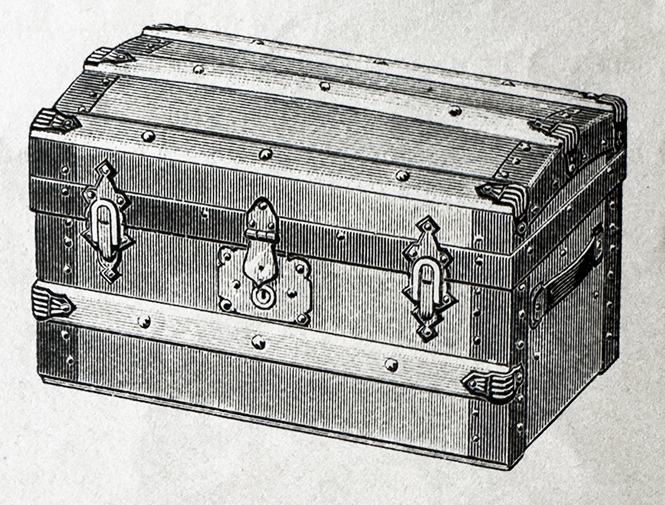
One could buy the doll and trunk together for $1.65 sent by express. The buyer had to pay postage when it was received.
Happy Family 1896
Doll collector’s may enjoy the advertisement for the Happy Family featured in 1896 revealing the faces of recognizable characters. The dolls of different races ranged from a petite 7 to 11 inches in height, all with bisque heads and jointed legs and arms. The set of five dolls sold together for $1.00 plus 40 cents for postage and packing. Many collectors today may recognize the German manufacturing.

Youth’s Companion Magazine Dolls Post 1900
Little Rosebud 1907-1911
Little Rosebud first came to America in 1900. She had a smiley face showing four teeth. Standing 15 inches tall she had a jointed kid leather body and boasted the unbreakable “Minerva” head. The photograph of the dolls shows she has bisque lower arms.
Rosebud came with paper patterns for making a Kimono, Coat, Wrapper, Red Riding-Hood Cape, Dress and Bonnet. The magazine offered a suitcase for Rosebud with her own toilet articles made of celluloid that included 1 comb, 1 powder box and puff, 1 mirror, 1 pair of side combs, 1 round comb and 1 fine comb. She also enjoyed a muff and boa of soft white fur and even a miniature hot water bottle! The 1911 volume provides a photograph of the dressing set.
In 1911 Rosebud came with paper patterns and folding bassinet. Her paper patterns had full instructions for making a French Dress, Tam O’Shanter, Middy Suit with Military Cape and Cap. The bassinet measured 18 inches high, 18 inches long and 8 inches wide.
Buschow & Beck of Nossen, Germany manufactured the Minerva doll heads. The magazine explains that the head attaches to the doll body and they offer heads with hair and glass eyes for doll bodies of 11 to 17 inches and then 19 inches , 21 inches, and 24 inches. They also offered heads with enameled eyes and hair for 9 to 13 inch doll sized bodies and 15 inches.
EARN THIS DOLL 1911
In 1911 Youth’s Companion offers a 26 inch doll without a name with a body of pink papier mache and head of bisque and curly human hair. She sold in stores for $7 and was fully jointed at neck, shoulders, elbows, wrists, hips and knees. She was one of the first wrist jointed dolls offered by Youth’s Companion magazine.
The doll wore a pretty lace-trimmed dress and beribboned chemisette, silk stockings, and silk slippers. Her face had an open mouth, eyelashes made of real hair, and eyes that open and closed.
A child could earn the doll by taking 35 orders for perfumes, soaps, teas, coffees, extracts etc.
Five-in-One Doll 1911
A celluloid doll with four extra heads appeared in 1911. The doll stood 9 ½ inches tall with jointed arms and legs. The heads included 1 boy’s head with “sandpapered” hair, 1 girl’s head with real hair, 1 cat’s head, 1 girl’s head with enameled hair, and 1 boy’s head with enameled hair. The magazine did not include clothing with the doll.
Candy Kid 1911
An American made character doll named “Candy Kid” appeared in 1911 in the Youth’s Companion at 12 inches tall. He came dressed in a striped romper with red cuffs, yoke and belt. He word socks and sandals, had jointed and movable arms and legs and a merry smile.
The magazine mentions nothing about his body but Candy Kid was manufactured by Effanbee.
Youth’s Companion Magazine Dolls of 1912
In 1912 the magazine offered a variety of dolls. The doll one could earn in 1911, Little Rosebud, and the Five-in-One doll, and Candy Kid (in a vertical striped romper) again appeared in 1912 in the October issue.
New to 1912 readers met the Campbell Kids, Baby Bobby, Toodles (an toddler doll), and Happy Hiram (in overalls and checked shirt) all American made unbreakable character dolls with cloth bodies and composition jointed heads and hands. Each doll measured 12 inches tall.
